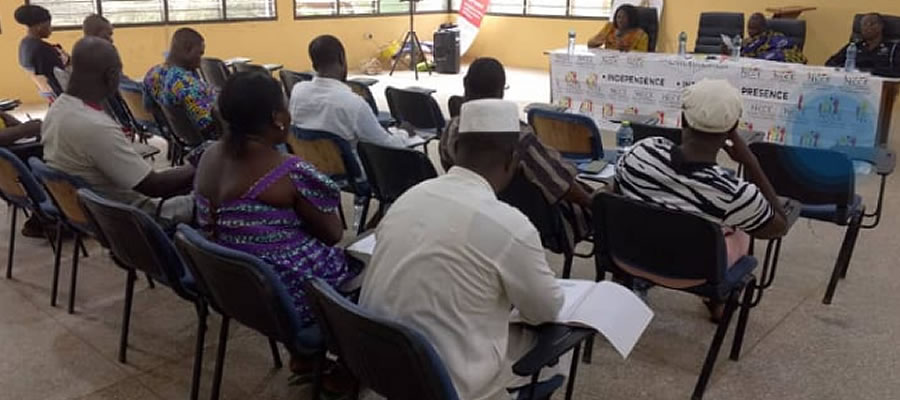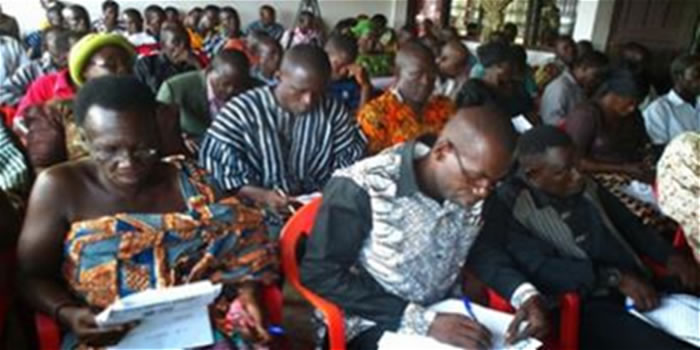

Economic Activities
The main economic activity of the people in the district is farming and it is practiced alongside other forms of economic activities. Major crops grown in the district are cassava, maize, plantain, citrus and vegetables (garden eggs and pepper). Non-traditional crops such as cashew and pineapples are also grown especially in the Mando and Abaasa zones. Besides farming, agro processing activities are spotted around the district. The most predominant of these are the processing of oil palm fruits to oil and cassava to gari either in groups or as individuals. Small and micro-scale industrial activities in woodcarving, masonry, carpentry and auto-mechanic are carried out.
The major economic activities in the service sector are ladies hairdressing, barbering, tele-communication services, few guest houses and "chop" bars. The economy of the district is largely agriculture driven. There are however a few small-scale agro-based and craft industries, trade and commerce. AEE is predominantly an agricultural district. Farming activities are carried out in such cash crops such as cocoa, palm-fruits, oranges, and vegetables. Cassava, plantain and maize are also grown on a large scale. There are no big industries in the district, however, there are small-scale gari, palm oil and palm kernel processing units in some communities.
The small scale and income generating activities include
• Palm oil/kernel extraction at Onwane under the organisation of National Council for Women and development (NCWD) and another at Essaman sponsored by Techno-serve.
• Cassava Processing at Entumbil Factory sponsored by the District Assembly and ASIP.
• Tweikukrom Cassava Processing Factory sponsored by the central Regional Development Commission (CEDCOM).
• A privately owned production starch at Ankukrom.
• Woodcarvings and bamboo beads making at Onwane, Kokoben, Enyan Miam and Bisease which are privates-enterprises.
• Kente weaving and soap making (liquid and cakes) at Ochiso and Breman Essiam
Analysis of POCC
Potential, Opportunities, Constraints and Challenges (POCC) Analysis.The POCC analysis is a tool used to streamline development issues and interventions before they are programmed for implementation. This analysis is important in helping to fine-tune development goals, objectives, policies and strategies. About twelve development issues of the AEE District have been subjected to this analysis.
Potentials
Potentials are latent strengths or untapped resources in the district, which are capable of being tapped for the district’s development. For example availability of bye laws on internal revenue generation.
Opportunities
They are positive and development enhancing factors that are external to the district, and on which the district does not have direct control. For example, availability of the DACF and HIPC Funds.
Constraints
Constraints are internal factors (within the district) that inhibit or restrict the district’s efforts to unearth and fully utilize its potentials. For example bad terrain and low communal spirit.
Challenges
They are negative external factors that inhibit the pursuit of development interventions in the district.
Investment and Business Potential
The Potential Analysis
Potentials are latent resources in the district, which are capable of promoting development in the district when tapped and used efficiently.The districts’ resource potentials were categorized into natural, human, institutional and infrastructure potentials. The derived potentials within each of these categories were further classified into first level and second levels.For instance, within the natural resources, irrigation potentials can be derived from the vast arable land in the district and the availability of water resources.
From the institutional potential realm, the capacity for local administration and governance can be derived from the existence of traditional authority and District Assembly. Besides, a vibrant local economy can be derived from a maximum use of road, electricity, telecommunication and water infrastructure in the district.The economy of the Ajumako-Enyan-Essiam District depends largely on agriculture, a few small-scale agro-based industries, trade and commerce, and to some extent, on its natural resources. Agriculture is the mainstay of the people, with 80 to 90% of the populace depending on it directly or indirectly.
The cultivable land area is about 74,400 hectares and about half of it is actually under cultivation.Basically, two forms of land tenure systems are practised in the district – the family land holding, which is favoured for cultivation of seasonal crops and the ‘abusa’ system employed generally for the long term cultivation of perennial crops. Abusa means dividing the farm produce or crops into three parts with the one cultivating the land taking two parts and the landowner taking a third. Average farm size is rather small and ranges between 0.0324 and 0.0608 hectares. The main food crops grown are cassava, maize, plantain, yam and cocoyam.
In Enyan-Maim zone, vegetables are also grown extensively, while in the recent past, different types of beans and cow-peas have been introduced in the Ba zone. It is estimated that, average yield per hectare for maize is 637 kg, cocoyam, 445 kg, and plantain, 5.7 tons. Cash crops, mostly perennials such as cocoa, citrus and oil palm, are cultivated extensively in the district. Cocoa cultivation is done mostly in the Sunkwa, Breman Essiam, Enyan Denyira and the Bisease zones. The cultivation of oil palm and citrus is done extensively and plays a significant role in the area and the cultivation of these crops is rising steadily.
Generally, livestock production in the district is underveloped, which leaves plenty of room for private investment to be made in a profitable manner. There are few commercial production activities, such as poultry, cattle or piggery farms. While output has been on the rise since 1992, the environment is ripe for enhancement of investment in this area. Industrial activity is restricted to agro-processing, which is done on large, medium and small-scale basis.The Nkwantanum West Africa Fruit and Food Processing Company used to be the major large-scale processing unit. Private capital is welcome to reactivate it since it holds great potential if recapitalised, retooled, and operated in a properly efficient manner.
Medium scale processing is carried out by edible processing activities at Owane, Essaman, Ochiso and Kromain, while Ochiso also hosts local soap making. The successes recorded by these firms is an indication that, the presence of abundant raw materials and cheap labour provides an enabling environment for such activities to be carried out with heavy profit margins. Being a forest area, timber is available in the district in large commercial quantities. Typical among these are the export types, including odum, wawa, emire and kyere.
The forest is also the main source of fuelwood, which is the main energy source of households in the district.The Ajumako-Enyan-Essiam District is also rich in minerals, although the sheer volume is not yet fully known since a complete geo-physical evaluation has not been done yet. So far, however, mica, kaolin and gold have been identified as being present in the district in commercial quantities. Mica is available over an approximate 13 kilometre area from Ampia-Ajumako stretching to the west. Kaolin is also found behind Ochi, over another 13 kilometre stretch between Ampia-Ajumako and Kwanyarko. There is gold at Nkwanase in the Enyan-Maim zone.
Finally, there is a stone quarry at Bedukrom in the Sunkwa zone. Commercial mining has not taken off properly, and most mining activity is done by artisans. Those that are engaged in such ventures are rather causing damage to the environment by indiscriminate digging for mica and gold. Therefore the District Assembly welcomes well-organised investors willing to apply scientifically and environmentally friendly mining techniques to exploit the vast natural resources in the district. Indeed, the District Assembly is fully committed to encouraging and assisting private investors, both local and foreign, to set up productive enterprises.
The local government also recognises that social development is generally determined by the provision of the conventional infrastructure projects in education, health, water and sanitation, housing, employment and gender issues. Adequate good road network and efficient transportation and communication systems are high on the District Assembly’s list of priorities in order to create the best possible enabling environment for private investors. Investors are assured of co-operation and assistance from the District Assembly.
District Finance
Performance of the Major Revenue Sources or Heads lor Internal Revenue Generation The total income and expenditure generally increased for the period 2001 to 2003, though not all the individual components have that general trend. Fees and fines increased over the same period from 32,450,000 cedis to 73,044,000 cedis. Between 1999 and 2000, rent increased by 23.3% and declined marginally in 2001 where it has averagely increased to date. Royalties’ payments have also increased dramatically over the years but declined in 2005. No market toll was collected from 1999 - 2005 according to the available data.
This is an indication of how poorly internally generated revenue is pursued in the district or a problem with the reporting and accounting system, because the district has 2 weekly markets and several daily markets and yet could not raise any revenue from market toll.There is therefore an urgent need to revamp the whole revenue collection and accounting procedures.Throughout the period under consideration Grant constitutes a major component of revenue for the Assembly. It forms 94.91% in 2000, 96.82% in 2001 and 92.59% in 2002. The other sources of revenue principally IGF took 5.09% in 2000. 18% in 2001 and 7.31% in 2002.
The above pattern indicates that the Ajumako district increasingly relies on Grants as her main source of revenue for her projects, while paying little attention to the other sources of revenue. It must be noted that development plans may generally be formulated, among other things, within the constraint of resource availability. If the assembly will continue to rely on Grants as her main source of income (revenue), then it is a serious indication of financial jeopardy since income derived from a single source is very crucial to the implementation of and development projects. Moreover this revenue source is often times not timely and reliable.
It is also subject to policy change and the district has no autonomy over it. Hence the future plans of the AEED must be carefully thought out. Though the available information is not enough for future predictions it is high time the assembly looked for other sources of income to finance her future development plans. Conscious efforts should therefore be made to improve internal revenue generation especially through market tolls. What prompts the urgent need for the revamp of the entire revenue collection procedures and an alternative source of revenue other than grants is the non-reliability of grants and the declining trends of the major revenue heads for internal revenue generation.
For example, investment income declined after 2000, rent declined from 1999 to 2000 and to the lowest level in 2003. Grant, the major source also declined.Though there were increases in fees and fines, licenses, royalties and rates, their impact is not so much felt since they form a very small percentage of the total revenue of the district. This highly inconsistent revenue yields from the various IGF sources makes evident existing problems with the district revenue collection, budgeting and accounting system. There is a need for a RIAP (Revenue Improvement Action Plan).
Human Resource Development Financing
As far as the poverty reduction strategy is concerned the assembly needs to improve on its capacity in managing the resources that are available to her. In this vein human resource development is very crucial in her activities and the district has over the year, been investing various amounts in this direction. Table 1.10.2 gives a summary of expenditure on human resources from 2001 - 2002. In 2001 a total of 068,511,922 were spent on human resource and 056,717,400 in 2002, constituting 3.11% and 3.23% of total revenue respectively.
Date Created : 11/14/2017 2:16:07 AM










 facebook
facebook
 twitter
twitter
 Youtube
Youtube
 +233 593 831 280
+233 593 831 280 0800 430 430
0800 430 430 GPS: GE-231-4383
GPS: GE-231-4383 info@ghanadistricts.com
info@ghanadistricts.com Box GP1044, Accra, Ghana
Box GP1044, Accra, Ghana